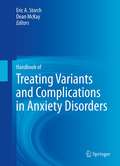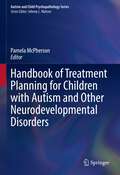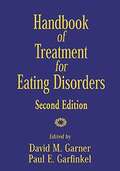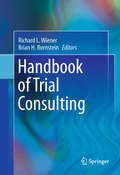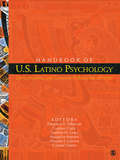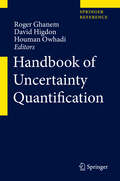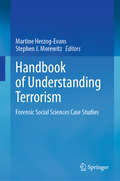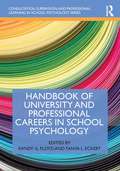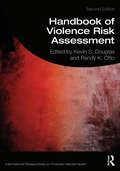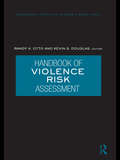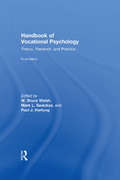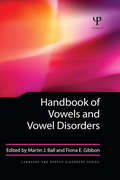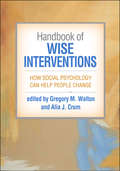- Table View
- List View
Handbook of Traumatic Loss: A Guide to Theory and Practice
by Neil Thompson Gerry R. Cox Robert G. StevensonThe Handbook of Traumatic Loss adopts a broad, holistic approach that recognizes traumatic loss much more fully as a multidimensional human phenomenon, not simply a medical condition. Initial chapters build a foundation for understanding traumatic loss and explore the many ways we respond to trauma. Later chapters counterbalance the individualistic focus of dominant approaches to traumatic loss by highlighting a number of thought-provoking social dimensions of traumatic loss. Each chapter emphasizes different aspects of traumatic loss and argues for ways in which clinicians can help deal with its many and varied impacts.
Handbook of Treating Variants and Complications in Anxiety Disorders
by Dean Mckay Eric A. StorchAs prevalent as anxiety is as a diagnosis, clinically complex cases are even more so. At the same time that it is recognized as a spectrum of disorders with many possibilities for intervention, it is most often seen with variations that further complicate treatment. The Handbook of Treating Variants and Complications in Anxiety Disorders explains in clear detail how and why clinical factors present challenges to clinicians treating clients with these disorders. Comorbid conditions often found in children, adolescents, and adults with anxiety, including developmental disabilities and personality disorders, are analyzed in the context of treatment. Case examples and literature reviews illustrate the relative merits of integrated versus sequential treatment, the importance of prioritizing behaviors, age-related considerations, and therapist issues. This best-practices approach guides readers in choosing current evidence-based options for treatment that is tailored to the individual and effective in the short and long term. Included in the Handbook: Prognostic indicators of treatment response for children and adults with anxiety disorders.Treatment of comorbid anxiety and disruptive behavior in youth.Treatment of PTSD with comorbid borderline personality disorder.Limited motivation, patient-therapist mismatch, and the therapeutic alliance.Assessment and treatment of comorbid anorexia nervosa and obsessive compulsive disorder.Treatment of comorbid anxiety disorders across the lifespan. Developed as a companion reference to the Handbook of Assessing Variants and Complications in Anxiety Disorders, the Handbook of Treating Variants and Complications in Anxiety Disorders is of immediate relevance to researchers, scientist-practitioners, and graduate students in clinical child, school, and developmental psychology; social work; psychiatry; psychotherapy; counseling; and pediatrics.
Handbook of Treatment Planning for Children with Autism and Other Neurodevelopmental Disorders (Autism and Child Psychopathology Series)
by Pamela McPhersonThis handbook addresses treatment planning for children with autism spectrum disorder (ASD) and other neurodevelopmental disabilities (NDDs) using a medical home perspective. It examines the medical home model, which has been promoted as the standard of care by the American Academy of Pediatrics since 2002, emphasizing collaboration between patients, families, and providers to optimize care. The handbook addresses treatment planning, including the coordination of the care provided by multiple specialists with a clear, shared vision for maximizing each child’s potential.Key areas of coverage include:· Elements of treatment planning, history of the medical home model, documentation, and strategies to facilitate communication.· Goals of treatment from the perspectives of the family, person served, care providers, and fiscal and regulatory bodies.· Role of each specialist, highlighting the most common conditions experienced by children with ASD and other NDD with expectations for assessment and treatment.· Detailed recommendations for making referrals and assisting the child and family in preparing for appointments.The Handbook of Treatment Planning for Children with Autism Spectrum Disorder and Other Neurodevelopmental Disabilities is a must-have resource for researchers, professors, and graduate students as well as clinicians, therapists, and other professionals across such interrelated disciplines as clinical child, school, and developmental psychology, child and adolescent psychiatry, social work, rehabilitation medicine/therapy, pediatrics, and special education.
Handbook of Treatment for Eating Disorders
by Paul E. Garfinkel David M. GarnerIn this seminal work, leading clinicians and researchers present the major treatments for eating disorders, including cognitive-behavioral, educational, psychodynamic, feminist, family-based, and medical approaches. <p><p>Therapeutic approaches are described in step-by-step detail and illustrated with extensive case material. Several chapters function as self-contained treatment manuals, enabling practitioners to easily learn and implement each model, as well as adapt it to suit the needs of individual patients. The volume also covers diagnosis, assessment, sequencing of treatments, and ways to manage frequently encountered co-occurring problems.
Handbook of Trial Consulting
by Brian H. Bornstein Richard L. WienerThis volume will be a handbook that treats trial consulting as applied psychology. The purpose of the volume will be to collect the viewpoints of leaders in the field of psychology and law who apply the discipline's theoretical models, methods, and ethics to assist litigators to try cases in the most effective way possible. As a whole, the collection of chapters will describe the theory, business, and mechanics of trial consulting for those interested in learning and practicing the profession. However, it will do so from the perspective of organized theories of jury-decision making. In other words, the work of juror researchers will inform the recommendations and suggestions in the handbook. The volume consists of six sections, each pertaining to a different topic. Multiple chapters with different authors will cover each topic. The topics and corresponding seven sections will be 1) An Introduction to the Theory and Psychology of Jury Decision-Making, 2) Applied Research Methodologies for Trial Consultants, 3) Education and Ethical Considerations for Trial Consultants, 4) Preparing and Cross Examining Witnesses, 5) Technology and Demonstrative Evidence at Trial, and 6) Special Topics in Trial Consulting. Each section will begin with the editors' short introduction reviewing that section and explaining its goals, objectives, and content. Separate individuals, recognized as leaders in their areas will write the remaining chapters in each section. These individuals come from the fields of both psychology and law, and represent viewpoints on these topics from a practice-oriented perspective, but a perspective that is emerges from research results. They are affiliated with a number of academic institutions, including University of Nebraska, John Jay College of Criminal Justice, University of Texas, University of Chicago Simon Fraser University, and private law firms.
Handbook of U.S. Latino Psychology: Developmental and Community-Based Perspectives
by Gustavo Carlo Dr Francisco A. Villarruel Dr Josefina M. Grau Margarita Azmitia Professor Natasha Cabrera Dr T. Jaime ChahinCongratulations to Aida Hurtado and Karina Cervantez- winners of the 2009 Women of Color Psychologies Award! This award, given by the Association of Women in Psychology Association, is voted on by AWP members for contributions of new knowledge and importance to the advancement of the psychology of women of color. Offering broad coverage of all U.S. Latino groups, this volume synthesizes cutting-edge research and methodological advances and provides culturally sophisticated information that can be used by researchers, policy makers, and practitioners. The editors and contributing authors summarize theories and conceptual models that can further our understanding of the development and adaptation of U.S. Latino populations. In addition, they focus on the importance of cultural sensitivity and competence in research and intervention approaches and how to achieve it. Key Features• Highlights the normative development and strengths of U.S. Latino populations • Elaborates on the heterogeneity of Latinos in that it does not assume that all Latino populations, and the contexts of their development, are identical. • Emphasizes on cultural sensitivity and competence at all levels• Focuses on the importance of cultural identity amongst Latinos and its contribution to healthy developmental outcomes.
Handbook of Uncertainty Quantification
by David Higdon Roger Ghanem Houman OwhadiThe topic of Uncertainty Quantification (UQ) has witnessed massive developments in response to the promise of achieving risk mitigation through scientific prediction. It has led to the integration of ideas from mathematics, statistics and engineering being used to lend credence to predictive assessments of risk but also to design actions (by engineers, scientists and investors) that are consistent with risk aversion. The objective of this Handbook is to facilitate the dissemination of the forefront of UQ ideas to their audiences. We recognize that these audiences are varied, with interests ranging from theory to application, and from research to development and even execution.
Handbook of Understanding Terrorism: Forensic Social Sciences Case Studies
by Stephen J. Morewitz Martine Herzog-EvansThis book examines common theoretical conceptualization of terrorism, including all the following dimensions: Macro-criminological theories Psycho-criminological models of aggression Psycho-criminological models of risk and need (RNR) Psychopathology Social psychology, particularly in the areas of intergroup relations, identity, need for closure, and, the quest for significance Ideological and religious passions and extremism International in scope, each chapter draws on a combination of these frameworks, exemplified in a collection of case series and studies, to help students, practitioners, and researchers better understand these phenomena.
Handbook of University and Professional Careers in School Psychology (Consultation, Supervision, and Professional Learning in School Psychology Series)
by Randy G. Floyd; and Tanya L. EckertThe Handbook of University and Professional Careers in School Psychology is a comprehensive resource for school psychologists in doctoral training or currently appointed to positions in universities and other clinical professional settings. Across 30 unique chapters, experts in the field offer diverse, experienced perspectives on accessing resources, building skills, navigating difficult experiences, and flourishing in all major facets of the profession. The book places special emphasis on development throughout the career lifespan and the empowerment of women, people of color, and scholars from outside of the United States.
Handbook of Violence Risk Assessment (International Perspectives on Forensic Mental Health)
by Kevin S. Douglas; Randy K. OttoThe Handbook of Violence Risk Assessment, Second Edition, builds on the first edition’s comprehensive discussion of violence risk assessment instruments with an update of research on established tools and the addition of new chapters devoted to recently developed risk assessment tools. Featuring chapters written by the instrument developers themselves, this handbook reviews the most frequently used violence risk assessment instruments—both actuarial and structured professional judgment—that professionals use to inform and structure their judgments about violence risk. Also included are broader chapters that address matters such as the consideration of psychopathy and how the law shapes violence risk assessment. Already the primary reference for practitioners, researchers, and legal professionals in this area, this second edition’s easy-to-access, comprehensive, and current information will make it an indispensable reference for those in the field.
Handbook of Violence Risk Assessment (International Perspectives on Forensic Mental Health)
by Randy K. OttoThis comprehensive Handbook of original chapters serves as a resource for clinicians and researchers alike. Two introductory chapters cover general issues in violence risk assessment, while the remainder of the book offers a comprehensive discussion of specific risk assessment measures. Forensic psychology practitioners, mental health professionals who deal with the criminal justice system, and legal professionals working with violent offenders will find the Handbook of Violence Risk Assessment to be the primary reference for the field.
Handbook of Vocational Psychology: Theory, Research, and Practice (Contemporary Topics In Vocational Psychology Ser.)
by W. Bruce Walsh Mark L. Savickas Paul J. HartungHandbook of Vocational Psychology identifies, reports, and evaluates significant developments in vocational psychology and career counseling, and in doing so provides both professional clinicians and students with an informed understanding of both the current state and continuing progress in the field. As in previous editions, the fourth edition links theory and research with the more applied aspects of this field: four sections cover, in order, the field's history, theory, research, and practical applications. Clinicians, students, and academics at all levels of experience will find that the Handbook of Vocational Psychology, 4th ed, paints an accurate picture of the realities of work and serves as a practical reference work for anyone interested in keeping up to date with the latest research and trends in vocational psychology.
Handbook of Vowels and Vowel Disorders
by Martin J. Ball Fiona E. GibbonIn the general study of speech and phonetics, vowels have stood in second place to consonants. But what vowels are, how they differ from one another, how they vary among speakers, and how they are subject to disorder, are questions that require a closer examination. This Handbook presents a comprehensive, cogent, and up-to-date analysis of the vowel, including its typical development in children's speech, description by perceptual and instrumental methods, cross-linguistic and sociolinguistic aspects, and disorders of its production and use. It approaches the problems of vowel production and perception from the viewpoints of physiology, physics, psychology, linguistics, phonetics, phonology, and speech-language pathology. The chapters are logically complementary, and the major sections of the book are like key dimensions of understanding, each adding a perspective and base of knowledge on vowels. The sum total of the chapters is a synthesis of information on vowels that has no precedent.
Handbook of Wise Interventions: How Social Psychology Can Help People Change
by Gregory M. Walton and Alia J. CrumPrecise shifts in the ways people make sense of themselves, others, and social situations can help people flourish. This compelling handbook synthesizes the growing body of research on wise interventions--brief, nonclinical strategies that are "wise" to the impact of social-psychological processes on behavior. Leading authorities describe how maladaptive or pejorative interpretations can undermine people&’s functioning and how they can be altered to produce benefits in such areas as academic motivation and achievement, health, well-being, and personal relationships. Consistently formatted chapters review the development of each intervention, how it can be implemented, its evidence base, and implications for solving personal and societal problems.
Handbook of Women, Stress and Trauma (Psychosocial Stress Series #Vol. 30)
by Kathleen A. Kendall-TackettThe Handbook of Women, Stress and Trauma focuses on the stresses and traumas that are unique to the lives of women. It is the first text to merge research from the fields of trauma and women's health and development. Using a lifespan developmental approach, the text begins by addressing specific issues women face in their lives, drawing upon theories of development and exploring how women's relationships with others buffer - or sometimes cause - stress and trauma. Combining aspects of female development with empirical data from the fields of women's health, family violence and stress and coping, this volume helps sensitive care providers to the specific needs of women exposed to traumatic events.
Handbook of Work Disability
by Johannes R. Anema Patrick LoiselThis book addresses the developing field of Work Disability Prevention. Work disability does not only involve occupational disorders originating from the work or at the workplace, but addresses work absenteeism originating from any disorder or accident. This topic has become of primary importance due to the huge compensation costs and health issues involved. For employers it is a unique burden and in many countries compensation is not even linked to the cause of the disorder. In the past twenty years, studies have accumulated which emphasize the social causes of work disability. Governments and NGOs such as the World Bank, the International Labor Organization, and the Organization for Economic Cooperation and Development have produced alarming reports on the extent of this problem for developed and developing countries. However, no comprehensive book is presently available to help them address this emerging field where new knowledge should induce new ways of management.
Handbook of Working with Children, Trauma, and Resilience: An Intercultural Psychoanalytic View (The\united Kingdom Council For Psychotherapy Ser.)
by Aida AlayarianThis book is a psychoanalytic discussion of the effects of trauma and torture on children, with a specific focus on how professionals can use an approach focused on resiliency rather than vulnerability to help the child reach wellbeing.Aida Alayarian argues that in a world where the torture, maltreatment, and neglect of children shamefully persist, it is incumbent upon all of us to intervene appropriately to put a stop to it. Whether in conference rooms developing a more comprehensive policy to hold perpetrators accountable, or working in clinics where traumatised children and their families seek help, the question of how we act to improve the opportunity for recovery in children and young people subjected to such inhumane treatment should be our primary concern. Handbook of Working with Children, Trauma, and Resilience discusses this salient issue, drawing on psychoanalytic perspectives of the effects of trauma on children, and looking specifically at the case of refugee children and families. Understanding challenging behaviour in traumatised children and the effects of refugee experience on families can help all concerned to offer more appropriate and effective support.
Handbook of Writing Research
by Steve Graham Jill Fitzgerald Charles A. MacArthurSynthesizing the breadth of current research on the teaching and learning of writing, the third edition of this definitive handbook has more than 90% new content, reflecting the growth and dynamism of the field. Leading scholars--including many international voices--review major theories, developmental issues, and instructional approaches for students at all grade levels. Cognitive and sociocultural aspects of writing are explored in depth, as are assessment principles and methods. Issues in teaching students with disabilities, multilingual students, and culturally diverse students are addressed. The volume discusses innovative research methods and educational technologies and identifies key directions for future investigation. New to This Edition Chapters on executive functions in writing; disciplinary writing in math, science, and social studies; the role of vocabulary in writing; and formative assessment. Chapters on source-based writing, source evaluation, and writing development and instruction for African American students. Chapters on sociocultural aspects of writing--from critical literacies to agency and identity, social justice issues, and more--plus an emphasis on integrating cognitive and sociocultural perspectives throughout.
Handbook of Writing Research, Second Edition
by Steve Graham Charles A. Macarthur Jill FitzgeraldThe definitive reference in the field, this volume synthesizes current knowledge on writing development and instruction at all grade levels. Prominent scholars examine numerous facets of writing from sociocultural, cognitive, linguistic, neuroscience, and new literacy/technological perspectives. The volume reviews the evidence base for widely used instructional approaches, including those targeting particular components of writing. Issues in teaching specific populations--including students with disabilities and English learners--are addressed. Innovative research methods and analytic tools are clearly explained, and key directions for future investigation identified. New to This Edition *Chapters on genre instruction, evaluation and revision, argumentative writing, computer-based instruction, and professional development. *Chapters on new literacies, out-of-school writing, translation, and self-regulation. *Many new topics and authors, including more international perspectives. *Multiple chapters connect research findings to the Common Core writing standards. See also the editors' Best Practices in Writing Instruction, Second Edition, an accessible course text and practitioner's guide.
Handbook of Youth Prevention Science
by Beth DollThe Handbook of Youth Prevention Science describes current research and practice in mental health preventive interventions for youth. Traditional prevention research focused on preventing specific disorders, e.g. substance abuse, conduct disorders, or criminality. This produced "silos" of isolated knowledge about the prevention of individual disorders without acknowledging the overlapping goals, strategies, and impacts of prevention programs. This Handbook reflects current research and practice by organizing prevention science around comprehensive systems that reach across all disorders and all institutions within a community. Throughout the book, preventive interventions are seen as complementary components of effective mental health programs, not as replacements for therapeutic interventions. This book is suitable for researchers, instructors and graduate students in the child and adolescent mental health professions: school psychology, school counseling, special education, school social work, child clinical psychology and the libraries serving them. It is also suitable for graduate course work in these fields.
Handbook of Youth Suicide Prevention: Integrating Research into Practice
by Regina Miranda Elizabeth L. JeglicThis handbook examines research on youth suicide, analyzes recent data on suicide among adolescents, and addresses the subject matter as a serious public health concern. The book explores the research on youth suicide, examining its causes, new and innovative ways of determining suicide risk, and evidence-based intervention and prevention strategies. In addition, it focuses on specific under-studied populations, including adolescents belonging to ethnic, racial, and sexual minority groups, youth involved in the criminal justice system, and adolescents in foster care. The book discusses how culturally informed and targeted interventions can help to decrease suicide risk for these populations.Key areas of coverage include:Early childhood adversity, stress, and developmental pathways of suicide risk.The neurobiology of youth suicide.Suicide, self-harm, and the media.Assessment of youth suicidal behavior with explicit and implicit measures.Suicide-related risk among immigrant, ethnic, and racial minority youth.LGBTQ youth and suicide prevention.Psychosocial treatments for ethnoculturally diverse youth with suicidal thoughts and behaviors.Technology-enhanced interventions and youth suicide prevention. The Handbook of Youth Suicide Prevention is an essential resource for researchers, professors, graduate students as well as clinicians, therapists, and other professionals in developmental psychology, social work, public health, pediatrics, family studies, child and adolescent psychiatry, school and educational psychology, and all interrelated disciplines.
Handbook of the Behavior and Psychology of Disease
by Victor R. Preedy Colin R. Martin Vinood B. Patel Rajkumar RajendramThis comprehensive handbook covers the entire range of physical disorders and their interrelated psychological problems. Behavioral changes, altered psychology, and in some cases, severe psychiatric conditions are frequent manifestations of communicable and non-communicable disease. While diseases have predictable trajectories, their psychological co-morbidities do not. This unpredictability, and sometimes lack of understanding can have profound effects on the professional, the patient, and the larger family unit. Mental health related domains of quality-of-life measure also impact the disease process but are often overlooked. Critical information targeted to experts within specialized areas can fail to reach a wider group of more general practitioners. This is complicated by the fact that psychological conditions may prompt organic disease, or conversely, disease may set off psychological disorders. This reference work creates the linkage between the two areas in a manner that is accessible to both experts and non-experts alike.
Handbook of the Biology and Pathology of Mental Disorders
by Victor R. Preedy Colin R. Martin Vinood B. Patel Rajkumar RajendramMental health disorders affect emotions, behavior and thought processes which impact on the day-to-day functioning and well-being of the individual, and the family unit. The consequences can be devastating and should be placed in the context that globally there are approximately 800 million people who have a mental health disorder, of which approximately 500 million have either depression or anxiety. Approximately 45 million people have bipolar disorder and 20 million have schizophrenia. Eating disorders affects 15 million people. Substance use disorders affects nearly a billion people worldwide. In many cases treatment can be carried out using pharmacological and nonpharmacological regimens. However, it is important to consider that the biological and pathological elements of these mental disorders are often overlooked, understanding which platforms for diagnosis and treatments. This comprehensive reference covers the full range of psychological disorders, examining the biological aspects of what is displayed as behavior. Each major psychological disorder receives its own chapter with information on genetic, chemical, and biological components that are key factors in the etiology and course of the pathology. The interrelationship of human behavior and physical health is a complex but critical part of understanding the mental condition, and this reference lays out a way of understanding the role of the biological mechanisms. This handbook is designed for psychologists, psychiatrists, judicial professionals, behavioral scientists, pathologists, psychologists, psychiatric nurses and doctors, neurologists, health scientists, general practitioners, research scientists and all those interested in altered behavior, mental health and disease. It is also valuable as a personal reference book and for academic libraries that cover behavioral or medical sciences.
Handbook of the Clinical Psychology of Ageing
by Robert T. Woods Linda ClareThe first authoritative reference on clinical psychology and aging, the Handbook of the Clinical Psychology of Ageing was universally regarded as a landmark publication when it was first published in 1996. Fully revised and updated, the Second Edition retains the breadth of coverage of the original, providing a complete and balanced picture of all areas of clinical research and practice with older people. Contributions from the UK, North America, Scandinavia and Australia provide a broad overview of the psychology of aging, psychological problems (including depression, anxiety, psychosis, and dementia), the current social service context, and assessment and intervention techniques.
Handbook of the Clinical Treatment of Infidelity
by Joseph L. Wetchler Fred P Piercy Katherine Milewski HertleinHelp your clients&’ relationships survive infidelity!In the Handbook of the Clinical Treatment of Infidelity, a panel of seasoned experts reflects on issues central to affairs, and on how to help couples heal and learn from them. First, editors Fred P. Piercy, Katherine M. Hertlein, and Joseph L. Wetchler provide an essential overview of infidelity theory, research, and treatment. They discuss the effect of infidelity on couples and delineate three types of infidelity-emotional, physical, and infidelity including aspects of both. They review the relatively new role of the Internet in infidelity and explore infidelity within the context of comarital relationships. Finally, they discuss the overarching theories and common models used in infidelity treatment.Also in the Handbook of the Clinical Treatment of Infidelity: Susan M. Johnson, the co-developer of Emotionally Focused Therapy (EFT), discusses affairs through the lens of attachment theory, and shows how EFT provides a way to acknowledge and express pain, remorse, and regret, and to repair this attachment bond. David Moultrup takes a Bowenian approach to infidelity, focusing attention on the underlying dynamics of the emotional system Frank Pittman and Tina Pittman Wagers outline cultural myths about affairs and do their share of debunking Adrian Blow discusses how to help couples directly address their pain-and the challenges of the healing process Brian Case highlights the role of apology and forgiveness in the healing process Frank Stalfa and Catherine Hastings focus on the treatment of "accusatory suffering"-a spouse&’s obsessive holding onto and retaliating for an affair long after it has ended, and despite the offending partner&’s repeated apologies and attempts at restitution Don-David Lusterman discusses individuals who have suppressed or denied traumatic stress reactions to their partner&’s affair, and how to help them Scott Johnson discusses myths about affairs, from who is cheating on whom, to whether men really have more affairs than women, to the blame-filled language of "affairs," "betrayal," and "infidelity," asking us to think more systematically about affairs and to see the dynamics of extra dyadic relationships as more complex and nuanced than they are typically portrayed in the literature Joan Atwood provides an overview of Internet infidelity-the factors influencing one&’s involvement in this type of infidelity, and some considerations for therapists Tim Nelson, Fred Piercy, and Doug Sprenkle report on the results of a multi-phase Delphi study that explored what infidelity experts say are the critical issues, interventions, and gender differences in the treatment of Internet infidelity Monica Whitty and Adrian Carr draw upon Klein&’s object relations theory and discuss how this might influence the way people rationalize their Internet infidelity Emily Brown outlines the concept of the Split Self Affair-discussing its origins, characteristics, and implications for individuals and couples, and providing detailed information on how to work with these couples in therapy Michael Bettinger presents extra dyadic relationship as a fact, rather than a problem, within many gay male relationships-a discussion that shows how gay male polyamory can work as an alternative to the heterosexual model of emotional and sexual exclusivity in romantic dyadic relationships Katherine Hertlein and Gary Skaggs report on the results of a study that assessed the level of differentiation and one&’s engagement in extra dyadic relationshipsThe Handbook of the Clinical Treatment of Infidelity is essential reading for today&’s (and tomorrow&’s) clinicians who work with couples. Make it a p

